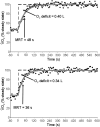High-intensity interval training accelerates oxygen uptake kinetics and improves exercise tolerance for individuals with cystic fibrosis
- PMID: 32308986
- PMCID: PMC7153226
- DOI: 10.1186/s13102-020-0159-z
High-intensity interval training accelerates oxygen uptake kinetics and improves exercise tolerance for individuals with cystic fibrosis
Abstract
Background: Exercise training provides benefits for individuals with cystic fibrosis; however, the optimal program is unclear. High-intensity interval training is safe and effective for improving 'functional capacity' in these individuals with peak rate of O2 uptake typically referenced. The ability to adjust submaximal rate of oxygen uptake (V̇O2 kinetics) might be more important for everyday function because maximal efforts are usually not undertaken. Moreover, the ability of high-intensity training to accelerate V̇O2 kinetics for individuals with cystic fibrosis could be enhanced with O2 supplementation during training.
Methods: Nine individuals with cystic fibrosis completed incremental cycling to limit of tolerance followed by 8 weeks of high-intensity interval cycling (2 sessions per week x ~ 45 min per session) either with (n = 5; O2+) or without (AMB) oxygen supplementation (100%). Each session involved work intervals at 70% of peak work rate followed by 60 s of recovery at 35%. For progression, duration of work intervals was increased according to participant tolerance.
Results: Both groups experienced a significant increase in work-interval duration over the course of the intervention (O2+, 1736 ± 141 v. 700 ± 154 s; AMB, 1463 ± 598 v. 953 ± 253 s; P = 0.000); however, the increase experienced by O2+ was greater (P = 0.027). During low-intensity constant-work-rate cycling, the V̇O2 mean response time was shortened post compared to pre training (O2+, 34 ± 11 v. 44 ± 9 s; AMB, 39 ± 14 v. 45 ± 17 s; P = 0.000) while during high-intensity constant-work-rate cycling, time to exhaustion was increased (O2+, 1628 ± 163 v. 705 ± 133 s; AMB, 1073 ± 633 v. 690 ± 348 s; P = 0.002) and blood [lactate] response was decreased (O2+, 4.5 ± 0.9 v. 6.3 ± 1.4 mmol. L- 1; AMB, 4.5 ± 0.6 v. 5.2 ± 1.4 mmol. L- 1; P = 0.003). These positive adaptations were similar regardless of gas inspiration during training.
Conclusion: Eight weeks of high-intensity interval training for patients with cystic fibrosis accelerated V̇O2 kinetics and increased time to exhaustion. This provides some evidence that these patients may benefit from this type of exercise.
Trial registration: This study was retrospectively registered in the ISRTCN registry on 22/06/2019 (#ISRCTN13864650).
Keywords: Cystic fibrosis high-intensity interval training oxygen supplementation∙V̇O2 kinetics functional capacity exercise tolerance.
© The Author(s). 2020.
Conflict of interest statement
Competing interestsFJD is editor of the Exercise Physiology section of BMC Sports, Science, Medicine and Rehabilitation.
Figures



References
-
- Santana-Sosa E, Gonzalez-Saiz L, Groeneveld IF, Villa-Asensi JR, Barrio Gómez de Aguero MI, Fleck SJ, López-Mojares LM, Pérez M, Lucia A. Benefits of combining inspiratory muscle with ‘whole muscle’ training in children with cystic fibrosis: a randomised controlled trial. Br J Sports Med. 2014;48(20):1513–1517. doi: 10.1136/bjsports-2012-091892. - DOI - PubMed
LinkOut - more resources
Full Text Sources

